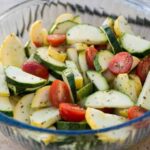Indulge your sweet tooth without the guilt! This guide unveils a collection of incredibly simple, low-carb desserts, each crafted with five ingredients or less. Imagine decadent treats—creamy, rich, and satisfying—prepared in minutes, not hours. Forget complicated recipes and lengthy ingredient lists; these recipes are designed for effortless baking and maximum flavor, perfect for busy weeknights or spontaneous dessert cravings. Prepare to discover a world of delicious possibilities, where healthy eating meets irresistible indulgence.
We’ll explore diverse flavor profiles, from the classic allure of chocolate to the refreshing tang of berries and the tropical charm of coconut. Learn about clever ingredient substitutions to personalize your desserts, catering to various dietary needs and preferences. Master simple techniques to achieve the perfect texture and taste every time, and discover creative serving suggestions to elevate these quick treats into elegant culinary experiences. Get ready to embark on a delightful journey of low-carb baking, where simplicity meets extraordinary taste.
Quick & Easy 5-Ingredient or Less Dessert Recipes
Indulge in delicious, low-carb desserts without spending hours in the kitchen. These recipes are designed for simplicity and speed, using readily available ingredients. Each dessert offers a delightful balance of flavors and textures, perfect for satisfying your sweet tooth while staying within your dietary goals.
Five Quick Low-Carb Dessert Recipes
Below are five delectable low-carb dessert recipes, each requiring five ingredients or less. These recipes emphasize ease of preparation and minimal cleanup, making them ideal for busy weeknights or spontaneous cravings.
| Recipe Name | Ingredients | Preparation Time | Image Description |
|---|---|---|---|
| Chocolate Avocado Mousse | Ripe avocado, unsweetened cocoa powder, erythritol or stevia, heavy cream, vanilla extract | 10 minutes | A rich, dark brown mousse, almost pudding-like in consistency, served in a small glass. The top is smooth and glossy, reflecting light subtly. |
| Peanut Butter Fat Bombs | Peanut butter, coconut oil, erythritol or stevia, unsweetened shredded coconut, vanilla extract | 5 minutes | Small, round balls of a light beige color, speckled with tiny bits of coconut. They appear firm and slightly sticky. |
| Chia Seed Pudding | Chia seeds, unsweetened almond milk, erythritol or stevia, vanilla extract, cocoa powder (optional) | 5 minutes prep, 2 hours chilling | A creamy, light brown pudding in a small glass. If cocoa powder is used, it will be a darker brown. The pudding has a slightly speckled appearance from the chia seeds. |
| Coconut Flour Cookies | Coconut flour, butter, erythritol or stevia, egg, vanilla extract | 15 minutes | Small, round cookies of a light golden brown color. They have a slightly crumbly texture and appear delicate. |
| Cream Cheese Frosting | Cream cheese, butter, erythritol or stevia, vanilla extract, heavy cream (optional) | 5 minutes | A fluffy, white frosting, smooth and creamy in appearance. If heavy cream is added, it will have a slightly softer texture. |
Detailed Recipe Instructions
Each recipe below provides step-by-step instructions to guide you through the process. Remember to adjust sweetness levels to your preference.
Chocolate Avocado Mousse
1. Combine 1 ripe avocado, 2 tablespoons unsweetened cocoa powder, 1 tablespoon erythritol (or to taste), 1/4 cup heavy cream, and 1 teaspoon vanilla extract in a food processor.
2. Blend until completely smooth and creamy.
3. Chill for at least 30 minutes before serving.
Peanut Butter Fat Bombs
1. Combine 1/2 cup peanut butter, 1/4 cup melted coconut oil, 1 tablespoon erythritol (or to taste), 1/4 cup unsweetened shredded coconut, and 1/2 teaspoon vanilla extract in a bowl.
2. Mix thoroughly until well combined.
3. Roll into small balls and refrigerate until firm.
Chia Seed Pudding
1. Combine 1/4 cup chia seeds, 1 cup unsweetened almond milk, 1 tablespoon erythritol (or to taste), and 1 teaspoon vanilla extract in a jar or container.
2. Stir well and refrigerate for at least 2 hours, or preferably overnight, to allow the chia seeds to absorb the liquid. Add cocoa powder for chocolate flavor.
Coconut Flour Cookies
1. Preheat oven to 350°F (175°C).
2. Combine 1 cup coconut flour, 1/2 cup melted butter, 2 tablespoons erythritol (or to taste), 1 egg, and 1 teaspoon vanilla extract in a bowl.
3. Mix until a dough forms.
4. Roll into small balls and flatten slightly.
5. Bake for 10-12 minutes, or until lightly golden brown.
Cream Cheese Frosting
1. Beat together 4 ounces cream cheese (softened), 2 tablespoons butter (softened), 2 tablespoons erythritol (or to taste), and 1 teaspoon vanilla extract until smooth and creamy.
2. For a lighter frosting, add 1-2 tablespoons of heavy cream and beat until fluffy.
Tips for Success and Troubleshooting

Creating delicious and satisfying low-carb desserts requires attention to detail. Success hinges on understanding the unique properties of low-carb sweeteners and the importance of proper ingredient ratios. Careful technique will ensure your desserts are both delectable and texture-perfect.
- Using the Right Sweetener: The choice of sweetener significantly impacts the final texture and taste. Erythritol, for instance, tends to have a cooling effect and doesn’t brown as readily as other sweeteners. Stevia, while intensely sweet, can sometimes leave a slightly bitter aftertaste if not used judiciously. Experimenting with different low-carb sweeteners – such as monk fruit or allulose – to find your preference is crucial. Consider the recipe’s specific requirements; some might benefit from a blend of sweeteners to achieve the desired sweetness and mouthfeel.
- Fat and Moisture Balance: Low-carb desserts often rely on fats for richness and moisture. An imbalance can lead to dry or crumbly results. Using the correct amount of fat, whether it’s butter, coconut oil, or cream cheese, is vital. Too little fat will result in a dry texture, while too much can make the dessert greasy. Recipes frequently call for eggs to add moisture and structure; ensure you’re using fresh, high-quality eggs.
- Baking Temperature and Time: Precise temperature control is essential for low-carb baking. Oven temperatures can vary, so using an oven thermometer is highly recommended. Overbaking can lead to dry, hard desserts, while underbaking results in a gummy or raw interior. Start checking for doneness a few minutes before the recommended time, using a toothpick or cake tester to gauge whether the center is cooked through.
- Ingredient Quality: Using high-quality ingredients is paramount. Fresh, ripe berries will deliver a superior taste compared to frozen or less-than-fresh options. Similarly, the quality of your nuts and seeds will affect the overall flavor and texture of the dessert. Choose ingredients with intense flavors to compensate for any potential sweetness reduction from using low-carb alternatives.
- Proper Measuring Techniques: Accurate measuring is crucial in baking, particularly with low-carb recipes where ingredient ratios are often carefully balanced. Use a kitchen scale for dry ingredients, ensuring accurate measurements for optimal results. For liquid ingredients, use measuring cups and spoons designed for liquid measurement.
Common Problems and Solutions
Many challenges can arise when baking low-carb desserts. Understanding these common issues and their solutions will significantly improve your baking success.
- Dry or Crumbly Texture: This often results from insufficient fat or moisture. Add a tablespoon or two of extra fat (melted butter or coconut oil) or an egg yolk to increase moisture. If using a powdered sweetener, consider lightly pulsing it with a bit of the fat before incorporating it into the rest of the mixture.
- Gummy or Raw Center: This usually means underbaking. Increase the baking time by a few minutes and check for doneness frequently. Use a toothpick or cake tester inserted into the center; it should come out clean when the dessert is fully baked.
- Bitter Aftertaste: This is sometimes associated with certain low-carb sweeteners, particularly stevia. Try using a different sweetener, or reduce the amount of stevia and balance it with another sweetener like erythritol.
- Uneven Baking: This could be due to inconsistent oven temperature. Use an oven thermometer to ensure accuracy and rotate the baking pan halfway through the baking process for even heat distribution.
- Dessert Falls Apart: This often indicates insufficient binding agents, such as eggs or nuts. Consider adding another egg or a tablespoon of nut butter to provide more structure.
Serving Suggestions and Presentation
Transforming simple, low-carb desserts into elegant presentations is surprisingly easy. A few thoughtful touches can elevate even the most basic recipe, making it suitable for a casual gathering or a more formal occasion. Consider the visual appeal, the accompanying flavors, and the ideal serving temperature to maximize the enjoyment of your creation.
Presenting these quick desserts requires a focus on highlighting their natural beauty and textures. Simple elegance is key; avoid overly fussy decorations that detract from the dessert itself.
Elegant Presentation Ideas
These three presentation styles offer different visual approaches, showcasing the desserts’ unique qualities.
First, consider individual serving sizes. Imagine a single scoop of creamy coconut mousse nestled in a delicate stemmed glass, perhaps with a dusting of cocoa powder creating a rich, dark contrast against the pale mousse. The glass’s transparency allows the creamy texture to shine through. Second, for a more rustic charm, try arranging a platter of almond flour brownies cut into small squares. Garnish each square with a fresh raspberry, its vibrant red popping against the rich brown of the brownie. A scattering of chopped pistachios adds a textural element and a pop of green. Lastly, a simple yet elegant presentation for a low-carb fruit crumble could involve serving it warm in small, individual ramekins. A scoop of vanilla ice cream (ensure it’s low-carb or sugar-free) alongside provides a cool counterpoint to the warm crumble.
Accompanying Flavors
The right accompaniments can enhance the flavors of your low-carb desserts and create a more complete sensory experience.
For the coconut mousse, a sprinkle of toasted coconut flakes adds textural interest and complements the coconut flavor. A drizzle of dark chocolate sauce adds a touch of bittersweetness. For the almond flour brownies, a dollop of lightly sweetened whipped cream offers a creamy contrast. Fresh berries, such as raspberries or blueberries, add a burst of tartness that balances the richness of the brownies. The fruit crumble is best served with a scoop of vanilla ice cream (again, ensuring it’s low-carb or sugar-free), enhancing the warmth of the crumble and providing a cool contrast. A dusting of powdered sugar substitute can add a touch of sweetness.
Serving Temperature and Storage
The ideal serving temperature and storage methods vary depending on the dessert.
The coconut mousse is best served chilled, allowing the flavors to meld and the texture to become smooth and creamy. Store it in an airtight container in the refrigerator for up to three days. The almond flour brownies are delicious served at room temperature or slightly warm. Store them in an airtight container at room temperature for up to three days, or in the refrigerator for up to a week. The fruit crumble is best served warm, straight from the oven. Leftovers can be stored in an airtight container at room temperature for up to two days or refrigerated for up to four days, reheated gently before serving.
Recipe and Step-by-Step Guide for a Single Dessert
This section provides a detailed, step-by-step guide for creating a decadent and simple Chocolate Avocado Mousse, a surprisingly delicious low-carb dessert requiring only five ingredients. The rich, creamy texture belies its healthy, low-carb nature, making it a perfect guilt-free indulgence.
Chocolate Avocado Mousse Recipe
This recipe showcases the versatility of avocado in creating a rich and creamy dessert without sacrificing flavor or texture. The simple steps ensure even novice bakers can achieve a delightful result.
- Preparing the Avocados: First, you’ll need one ripe but firm avocado. Imagine a perfectly ripe avocado, its skin a deep, vibrant green, yielding slightly to gentle pressure. Cut the avocado in half lengthwise, remove the pit, and scoop the flesh into a medium-sized bowl. The image shows the avocado, halved, revealing its creamy, pale green flesh. The pit is removed, and the flesh looks smooth and ready for processing.
- Adding the Sweetener and Cocoa Powder: Next, add 2 tablespoons of your preferred low-carb sweetener (erythritol or stevia work well). Picture a fine, white powder, almost like granulated sugar, being gently stirred into the avocado. Then, incorporate 2 tablespoons of unsweetened cocoa powder. The image depicts the cocoa powder, a rich dark brown, swirling into the avocado mixture, creating a marbled effect. The mixture is starting to take on a deeper, chocolatey hue.
- Incorporating the Vanilla Extract: Now, add 1 teaspoon of pure vanilla extract. Visualize a small, clear bottle of vanilla extract, its potent aroma filling the air. A single teaspoon is added to the bowl, its essence mingling with the chocolate and avocado. The image shows a small drop of vanilla extract falling into the bowl, creating tiny ripples in the mixture. The scent is subtly apparent.
- Blending the Ingredients: Using an immersion blender or a regular blender, blend all the ingredients until completely smooth and creamy. Imagine the blender whirring, transforming the initially chunky mixture into a luxurious, velvety smooth chocolate mousse. The image showcases the final product – a dark, rich chocolate mousse, its texture thick and glossy, perfectly smooth without any lumps.
- Chilling and Serving: Pour the mousse into individual serving dishes or ramekins. Picture small, elegant glasses or bowls filled with the dark, glossy mousse. Refrigerate for at least 30 minutes to allow the mousse to chill and set. The image depicts the mousse, now chilled, its texture firm yet still creamy, ready to be served. It has a beautifully smooth surface, reflecting light.
Unleash your inner pastry chef with these incredibly easy low-carb dessert recipes! From the initial ingredient selection to the final flourish of presentation, each step is designed for ease and enjoyment. We’ve covered a variety of flavors, ingredient swaps, and troubleshooting tips to empower you to create delicious and satisfying desserts effortlessly. Remember, these recipes are not just about satisfying your cravings; they are about reclaiming the joy of baking with simple, healthy ingredients and minimal effort. So, gather your ingredients, choose your favorite recipe, and get ready to experience the magic of quick, low-carb indulgence!
Key Questions Answered
Can I use sugar substitutes other than those listed?
Yes, many sugar substitutes can work, such as erythritol, stevia, or monk fruit. Adjust the amount based on the sweetness level of your chosen substitute.
How long can I store these desserts?
Storage time varies depending on the recipe and ingredients. Most will last 2-3 days in the refrigerator, covered.
What if my dessert doesn’t set properly?
This might be due to insufficient chilling time or incorrect ingredient ratios. Ensure you’ve followed the recipe precisely and allow adequate chilling time.
Can I freeze these desserts?
Freezing is possible for some recipes, but it may affect the texture. Check individual recipe notes for freezing instructions.


